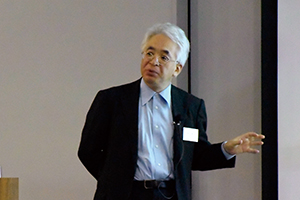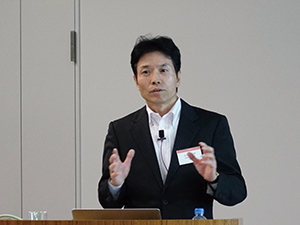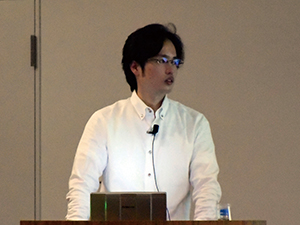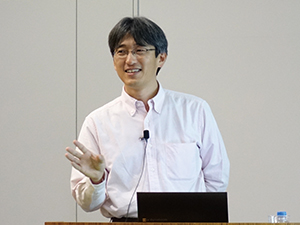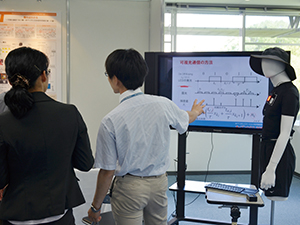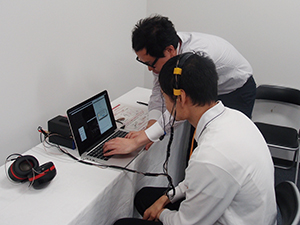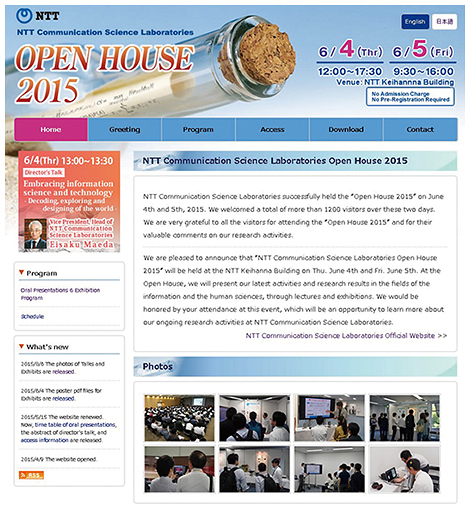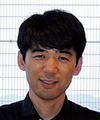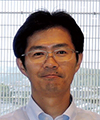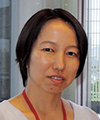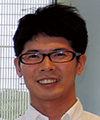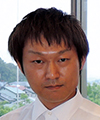 |
|||||||||||||||||||||||
|
|
|||||||||||||||||||||||
|
Information Vol. 13, No. 11, pp. 49–54, Nov. 2015. https://doi.org/10.53829/ntr201511in1 Event Report: NTT Communication Science Laboratories Open House 2015AbstractNTT Communication Science Laboratories Open House 2015 was held in Keihanna Science City, Kyoto, on June 4 and 5, 2015. Over 1200 visitors attended the event and enjoyed 5 talks and 30 exhibits focusing on our latest findings and activities in the fields of information and human sciences. Keywords: information science, big data, human science 1. OverviewAt NTT Communication Science Laboratories (NTT CS Labs) located in Seika-cho, Kyoto, and Atsugi City, Kanagawa, we aim to build new technical infrastructures connecting people and information by creating innovative technologies and discovering new principles. The targets of NTT CS Labs are the most fundamental research topics in the fields of information and human sciences. NTT CS Labs Open House has been held annually for the purpose of introducing our innovative technologies and new findings in basic research to many visitors from the NTT Group, other industries, universities, and research institutions who are engaged in research, development, business, and education. This year, Open House was held at the NTT Keihanna Building in Kyoto on June 4 and 5, and over 1200 visitors attended it over the two days. We prepared many hands-on exhibits to allow visitors to intuitively understand our latest research results and to share a vision of the future where new products based on the research results are widely used. We also organized an invited talk on the themes of human interfaces and robotics. This article summarizes the event’s research talks and exhibits. 2. Keynote speechOpen House started with a speech by Director of NTT CS Labs, Eisaku Maeda, entitled “Embracing information science and technology—Decoding, exploring and designing the world” [1] (Photo 1).
In this talk, he mentioned that the era in which people are confronted with machines (e.g., computers and artificial intelligence) is coming to an end, and we humans will need to internalize information science and technology as part of ourselves. He also stressed that many researchers need to acquire the ability to decode, explore, and design the entire world including us (i.e., humans). Moreover, he argued that while bearing in mind the drastic changes in the information environment that we have experienced in the first 15 years of the 21 century, we must think about what concepts should make up basic research that will form the compass of the future as we envision the year 2030, 15 years from now. He proposed a new direction on information science and technology, and stressed the importance of three new frameworks: Measuring to Understanding, Analysis to Exploration, and Implementation to Design. 3. Research talksThree research talks were held that highlighted the recent significant findings and activities of NTT CS Labs. Each talk provided an overview of the research field and introduced the latest research results. All of the talks were very well received. (1) “‘When’, ‘where’, ‘what’, and ‘how’?—Spatio-temporal multidimensional data analysis for IoT* big data,” by Naonori Ueda, Machine Learning and Data Science Center [2]. He introduced the basic concepts and some examples of spatio-temporal multidimensional collective data analysis that can predict when, where, and what in real time and provide feedback to social systems (Photo 2).
(2) “What is this? Who is it? Where am I?—Recent advances in real-world media search technology and future,” by Masaya Murata, Media Information Laboratory [3]. He summarized previous work in the field of media search and then introduced recent findings and activities on his project on instance search technology (Photo 3).
(3) “Hidden hearing processes unveiled—Exploring auditory mechanisms by biological measures,” by Shigeto Furukawa, Human Information Science Laboratory [4]. He explained current findings and the direction of auditory mechanism research and then introduced innovative methods for measuring human auditory ability by using multiple biological responses to visual as well as auditory stimuli (Photo 4).
4. Research exhibitsOpen House featured 30 exhibits displaying our latest research activities. The exhibits were classified into four categories: (1) big data science, (2) computer science, (3) media intelligence, and (4) communication and human science. Each exhibit was housed in a booth and employed slides on a large-screen monitor or hands-on demonstrations, with researchers explaining the latest results directly to visitors. The following list summarizes the research exhibits in each category. More details including the names of researchers associated with each exhibit can be found on the Open House website [5, 6]. 4.1 Big data science(1) Automatic tailor-made data analysis —Generating probabilistic models using structure information— (2) Finding various factors hidden in data —Advanced and fast high-dimensional multiple factorization— (3) Infinite data analysis beyond big data —Stochastic process models for infinite-dimensional matrices— (4) Fast graph analysis by efficient CPU utilization —Scalable parallel graph processing by reordering— (5) Efficient knowledge discovery from large-scale graph —Efficient structure mining for large-scale graph— (6) Agile environmental sensing —CILIX: a virtual machine for wireless sensor network applications— (7) Satisfying visitors with collective navigation while predicting people flow —Spatio-temporal data analysis for controlling massive people flow— (8) Traffic flow aggregation for traffic engineering —Classifying flows based on traffic variation pattern— (9) ESKORT: mining expert knowledge from trouble ticket —Automatic workflow extraction from unstructured texts for network operation— 4.2 Computer science(10) Can you beat TOROBO-kun? —Evaluating the naturalness of sentences using language models— (11) “Wanwan” is easier to learn than “inu” —Exploring differences in learnability of IDS and ADS words in children— (12) Better Japanese understanding helps better translation —Pre-ordering machine translation by deep syntactic analysis— (13) Finding the best combination within budget —Combinatorial optimization using binary decision diagram— (14) Quantum computer using noisy environment —Identification of untouchable quantum system— (15) Guaranteeing randomness —A new concept toward reliable physical random bit generation— 4.3 Media intelligence(16) Analyzing, synthesizing and converting speech prosody —Generative modeling of voice fundamental frequency contours— (17) Understanding by capturing —Simultaneous multi-biosignal sensing by visible light communication— (Photo 5)
(18) Connecting what you see to the information world —Real-world information retrieval by media search technology— (19) Recovering perfectly-sounding speech by denoising —High-quality speech enhancement using vast amounts of examples— (20) Extracting essential information from sounds —Advances in distant speech recognition by deep learning— (21) Measurement of fluorescence by 9-eye camera —“Shitsukan” reproduction using reflection and fluorescent of objects— 4.4 Communication and human science(22) ICT support for mental health care —Understanding the burden of family caregivers of a depressed individual— (23) Who will start speaking next and when? —Predicting next speaker and timing using gaze and breathing— (24) Human thermal sense doesn’t work as a thermometer —Exploring mechanisms of human thermal information processing— (25) New text communication using finger tracing —Creating dynamic texts using “Yu bi Yomu” applications— (26) Hen-Gen-Tou (Deformation Lamps) —Amazing illumination to make static objects dynamic— (27) Where is my hand? —Bodily response induced by an illusion in the sense of body— (28) I can speak like a native —Speaking rhythm conversion rules by English speech corpus— (29) Getting the knack of action and player’s condition —Body / mind reading & feedback system for sports— (30) We can see how you hear —Biological measures for auditory experience— (Photo 6)
5. Invited talkThis year, we invited Prof. Masahiko Inami from Keio University’s Graduate School of Media Design. He gave a talk entitled “Initial step towards augmented human.” He talked about his work on the augmentation of human senses and perception by technology. One of his well-known research topics is an optical camouflage cloak, which enables a masked object to be observed as if it were virtually transparent. He demonstrated his efforts to make a car’s backseat virtually transparent and allow drivers to see the road behind the backseat. He has been developing the concept of augmented humans, and recently founded the Superhuman Sports Society, which is creating and promoting sports played using augmented human technologies. 6. Promotion using the webTo inform many people about our research activities, we created both Japanese [5] and English websites [6] for Open House 2015, which included a booklet, exhibition posters, and reference information (Fig. 1). We also uploaded photos of exhibition halls and videos of the three research talks and the Director’s keynote speech. Furthermore, we tweeted about the exhibition events via Twitter [7] and Facebook [8] through NTT’s Public Relations Office, and we provided an online research lecture via the video streaming platform “niconico Live” offered by Dwango Co., Ltd. [9]. In this lecture, Hirokazu Kameoka (Media Information Laboratory) talked about analyzing, synthesizing, and converting speech prosody, and he received many online comments from about 500 anonymous web users [10]. Thus, NTT CS Labs is continuously trying to improve the ways of disseminating our research activities and results.
7. Concluding remarksFollowing the success of last year’s event, many visitors came to NTT CS Labs Open House 2015 and engaged in lively discussions on the research exhibits and talks. All of the advice and comments from visitors are very valuable to the members of NTT CS Labs, and they help to support and speed up our research activities. Therefore, we would like to offer our sincere thanks to all of the visitors and participants who attended this event. References
|
|||||||||||||||||||||||

